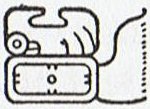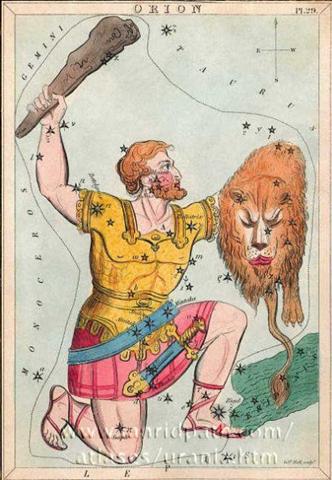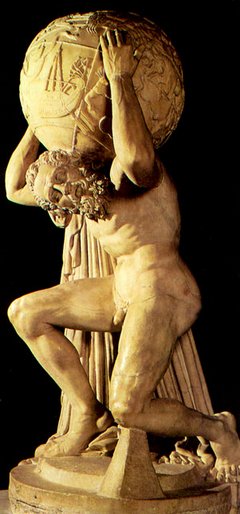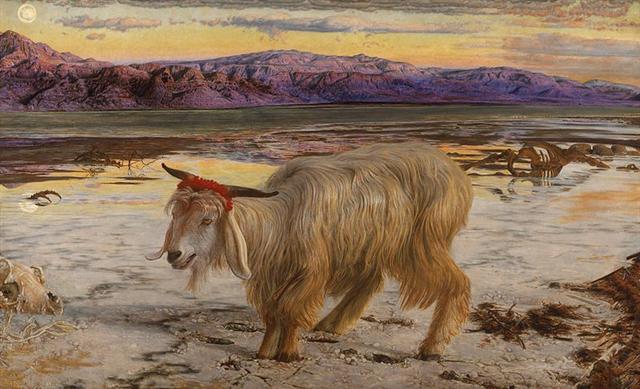I imagine Hevelius may have tried to visualize how some great changes would occur between Crater and Corvus, deep down at the great bend of the tail of the 'Water Snake': 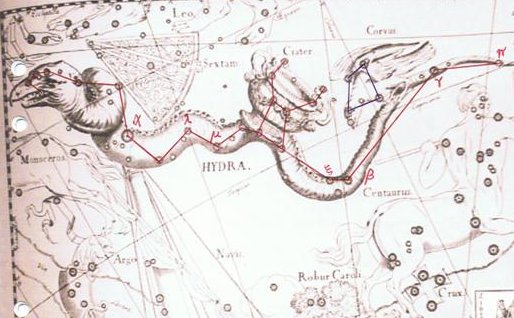 This place should be in Pu Pakakina A Ira and more precisely where there are 3 stars at the very bottom of the bend, viz. ξ, ο, and β Hydrae.
At the beginning of the G text May 20 (144) came 64 days after the March equinox. The month ought to have been Vaitu potu and the main water month, Vaitu nui, should have been in the past. Then followed the dry (maro) season with the month He Maro:
"On the twenty-fifth day of the first month ('Vaitu Nui'), Ira and Makoi set sail; on the first day of the month of June ('He Maro'), the bow of Ira's canoe touched land again." (Manuscript E, p. 17.) The creators of Manuscript E may have thought the idea of reaching dry land necessitated a harmony in time. Not only is land dry in contrast to the sea, but the concept of dry alludes to the concept of old age. Young people are pliable and old people not. He Maro was probably regarded as the last month of the old year. At the beginning of the voyage of the explorers - in Vaitu Nui - their voyage was 'young', at its end it was 'old'. The sea voyage of the explorers should end precisely at the first day of He Maro. Looking back in the glyph text, we will find He Maro 1 (= June 1) after Ga1-7 when Denebakrab (Tail of the Scorpion, μ) was close to the Full Moon. Could Ira and Makoi refer to a pair of stars in Orion (down where the ecliptic path of the Sun was not reaching)? The number of explorers was 7, but after Kuukuu went into his cave they were only 6. In my star list I have 6 π stars in Orion:
The reason for the wet skin of the dead old Lion in Orion could be connected with these 6 corner 'stars' (Tau-Ono). Beyond the blue line of the Milky Way a new land was rising up from the waves of time. Counting from Atlas (56.3) and 16 days ahead - in order to find his first reappearance beyond the Sun - gives as the result 72.3.
... On the fifth day of the month of July ('Anakena'), they all got up, went downhill, went on, and reached Hanga Te Pau. They took the provisions with them, carrying them on their shoulders, went on, and reached Te Pou. They made camp and slept in Te Pou on the tenth day of the month of July ('Anakena'). Then they all got up, carried their provisions on their shoulders, went straight ahead, and followed the path of the dream soul of Hau Maka... Like Atlas they carried their burdens on their shoulders. "... 'Year Bearer' literally translates a Mayan concept. Its importance resides in two facts. For one, the four years headed by the Year Bearers are named after them and share their characteristics; therefore, they also have their own prognostications and patron deities. Moreover, since the Year Bearers are geographically identified with boundary markers or mountains, they help define the local community. The classic system of Year Bearers described above is found at Tikal and in the Dresden Codex. During the Late Classic period a different set of Year Bearers was in use in Campeche. In this system, the Year Bearers were the Tzolk'in that coincided with 1 Pop. These were Ak'b'al, Lamat, B'en and Edz'nab. During the Post-Classic period in Yucatßn a third system was in use. In this system the Year Bearers were the days that coincided with 2 Pop: K'an, Muluc, Ix and Kawak. This system is found in the Chronicle of Oxkutzcab. In addition, just before the Spanish conquest in Mayapan the Maya began to number the days of the Haab' from 1 to 20. In this system the Year Bearers are the same as in the 1 Pop - Campeche system. The Classic Year Bearer system is still in use in the Guatemalan highlands and in Veracruz, Oaxaca and Chiapas, Mexico." (Wikipedia) Using the Gregorian calendar instead of the updated star calendar the date ║June 1 (*72) had its opposite side of the year at ║December 1 (*255):
Haedus II rose with the Sun in ║May 31 (151). The Goat in question should be the Winter Goat (Capricorn) whose rule was ending here, to be driven away:
| |||||||||||||||||||||||||||||||||||||||||||||||||||||||||||||||||||||||||||||||||||||||||||||||||||||||||||||||||||||||||||||||||||||||||||||||||||||||||||||||||||||||||||||||||




